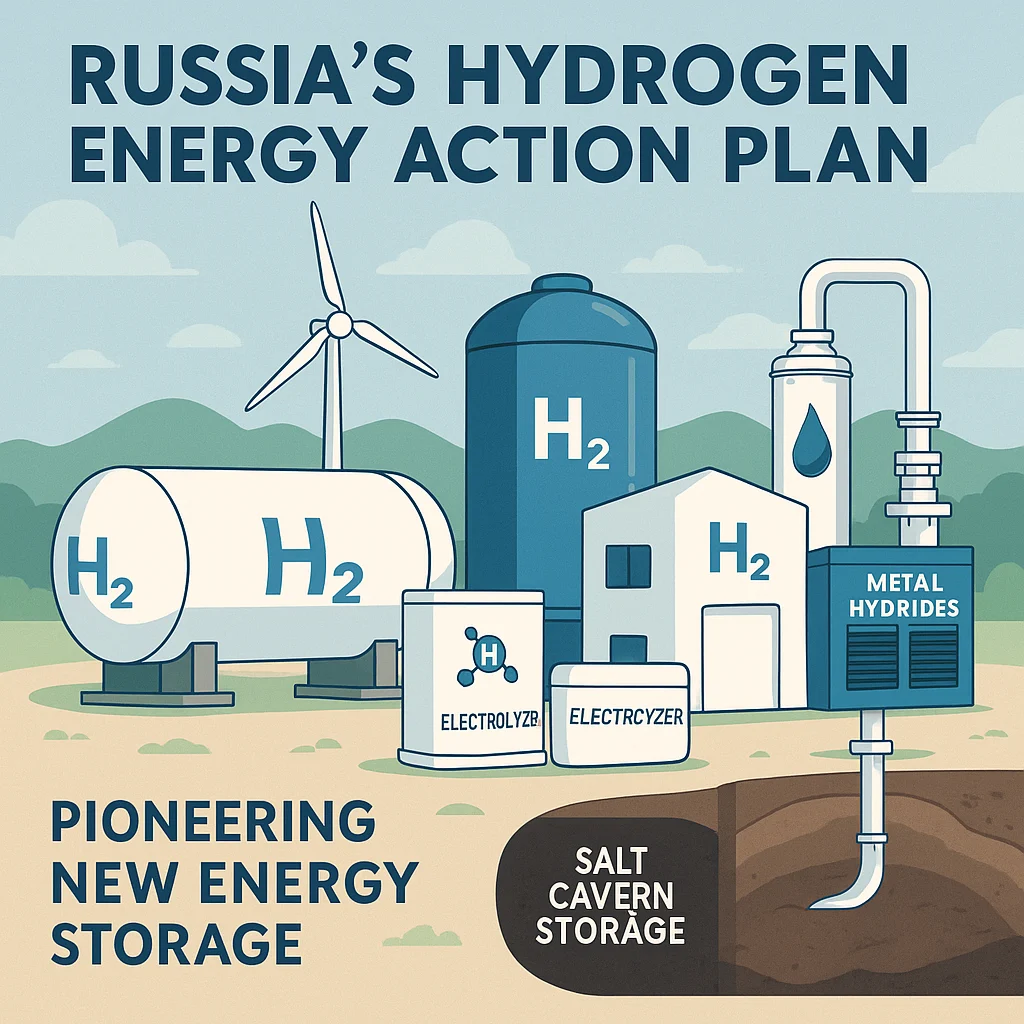Hydrogen Energy Development in Russia: The Role of Storage Solutions in the 2024 Action Plan
2025-05-09
Russia's 2024 Action Plan for Hydrogen Energy Development accelerates its move towards a low-carbon hydrogen economy with an end-year export goal of 0.2 Mt and the groundwork for 2 Mt by 2035. The plan invests ₽9.3 billion (~US $125 M) of public funds to push electrolysis, methane pyrolysis, and new subterranean extraction technologies to commercialization—all underpinned by strategic storage solutions to smooth out intermittent renewable feedstocks and supply chains. Emerging storage technologies include gaseous and cryogenic liquid hydrogen high-pressure tanks, solid-state metal hydrides, and geological salt cavern schemes to store intermittent renewables and nuclear-powered electrolysers' output. Pilot schemes like Sakhalin's 30 kW solar-powered electrolyser and Skoltech's in-well hydrogen pilot extraction tests demonstrate integrated production-storage concepts, and ministry-planned Northwest, Far East, Arctic, and Southern hubs plan to locate generation, storage, and export facilities together. In spite of momentum, techno-economic feasibility, regulatory frameworks, and infrastructure readiness challenges will determine the position of storage solutions in facilitating Russia's hydrogen dreams over the next decade.

Audience and Content Analysis
The three main audiences that the article addresses are:
- Policy Makers & Regulators, who need concise inputs on the 2024 Action Plan's storage-related targets, subsidy structures, and licensing reforms for hydrogen to be included in Russia's energy mix.
- Industry Investors & Project Developers, seeking techno-economic data—estimates of tank storage capital costs, the feasibility of geological caverns, and estimated IRRs—to evaluate downstream and export-directed hydrogen infrastructure.
- Technical Experts & R&D Leaders, seeking cutting-edge hydrogen storage technology (metal hydrides, cryogenic tanks, salt caverns), control-system integration, and pilot project outcomes to guide design and scale-up.
To satisfy both Google's algorithms and user demand, the article tempers technical jargons—i.e., "round‐trip efficiency," "pressure‐rated composite tanks," and "thermal management in liquefaction systems"—with narrative journalism, e.g., analogies (e.g., salt caverns as "subterranean gas banks") and strategic H2/H3 headings for scannability.
Russia's 2024 Hydrogen Action Plan: Overview
Strategic Targets
- Export Milestones: Achieve 0.2 Mt of hydrogen exports by end-2024, growing to 2 Mt by 2035 within the Energy Strategy to 2035.
- Public Investment:Invest ₽9.3 billion (~US $125 million) in R&D, pilot production, and first-of-a-kind storage infrastructure by 2024.
- Regional Hubs:Establish four research and production hubs—in the Northwest (EU exports), Far East (Asian markets), Arctic (low-carbon feedstocks), and South (renewables integration)—to collocate electrolysers, storage, and logistics.
Production Pathways
- Electrolysis Scale-Up: Alkaline and PEM electrolysers on large scales powered by nuclear and renewable energy, with 500 MW of installed capacity in 2024.
- Methane Pyrolysis (Turquoise Hydrogen):Pilot-plant units utilizing methane pyrolysis for the manufacture of solid carbon and hydrogen with zero direct CO₂ emissions.
- In-Well Generation: Skoltech's in-well technology for H₂ production sequesters H₂ in situ and leaves carbon in the reservoir, with minimal surface emissions.
The Critical Role of Storage Solutions
Pressurized and Cryogenic Storage
- Composite Pressure Vessels: Carbon-fiber composites of high strength uprated to 350-700 bar for on-road and on-road bulk tank storage, with 98 % volumetric utilization.
- Liquefied Hydrogen Tanks: Cryogenic tanks –253 °C to store hydrogen at 70 kg/m³ density, the key to long-distance export and mass-scale buffering.
Solid-State & Subsurface Storage
- Metal Hydride Systems: Alloys (LaNi₅, MgH₂) for reversible hydrogen sorption at low pressure, permitting stable storage for grid-scale utilization.
- Salt Cavern Projects: In-progress feasibility studies to make use of evaporite domes to store hydrogen underground, seeking Russia's geology expertise to store gigawatt-hours of H₂.
Pilot and Demonstration Projects
Sakhalin Green Hydrogen Initiative
- 30 kW Solar-Powered Electrolyser: Operational since mid-2023, complemented by 50 kg pressurized storage tanks to supply fuel for remote grid stabilization.
- First Experimental Green Hydrogen Plant: Proves integration of PV, electrolyser, and storage in a compact skid for islanded applications.
Arctic and Far East R&D Pilots
- Rosatom Blue Hydrogen Pilots: Five plants capturing CO₂ from gas reforming with subsurface sequestration, together with 100 kg hydride storage modules for base load mode.
- White Hydrogen Exploration: Gazprom pilot extracting natural hydrogen in Siberia's crystalline deposits, evaluated in combination with cavern storage concepts.
Challenges and Next Steps
- Techno-Economic Viability: Electrolyser and storage tank high capex (~US $1,000–$1,500/kW electrolyser; $800–$1,200/kg tank) necessitates scale-up and cost-reduction paths.
- Regulatory Structure: Need for specific hydrogen storage licensing separate from natural gas legislation, clearly established safety protocols, and underground cavern permit procedures.
- Infrastructure Readiness: Refurbishment of ports, rail, and pipeline to accommodate cryogenic liquid H₂ and high-pressure gas, and integrated SCADA and Energy Management System platforms to facilitate real-time scheduling and dispatch.
- Market Coordination: Domestic offtake—ammonia production, steel decarbonisation, heavy transport—and export corridors alignment for storage optimization and bottleneck avoidance.
Through the integration of ambitious storage technologies along value chains—surface tanks to subsurface caverns—Russia's Action Plan 2024 lays the ground for a strong, export-driven hydrogen economy. Enabling this will rely on overcoming cost, regulatory, and logistically related hurdles to turn policy ambition into Green Energy leadership globally.
